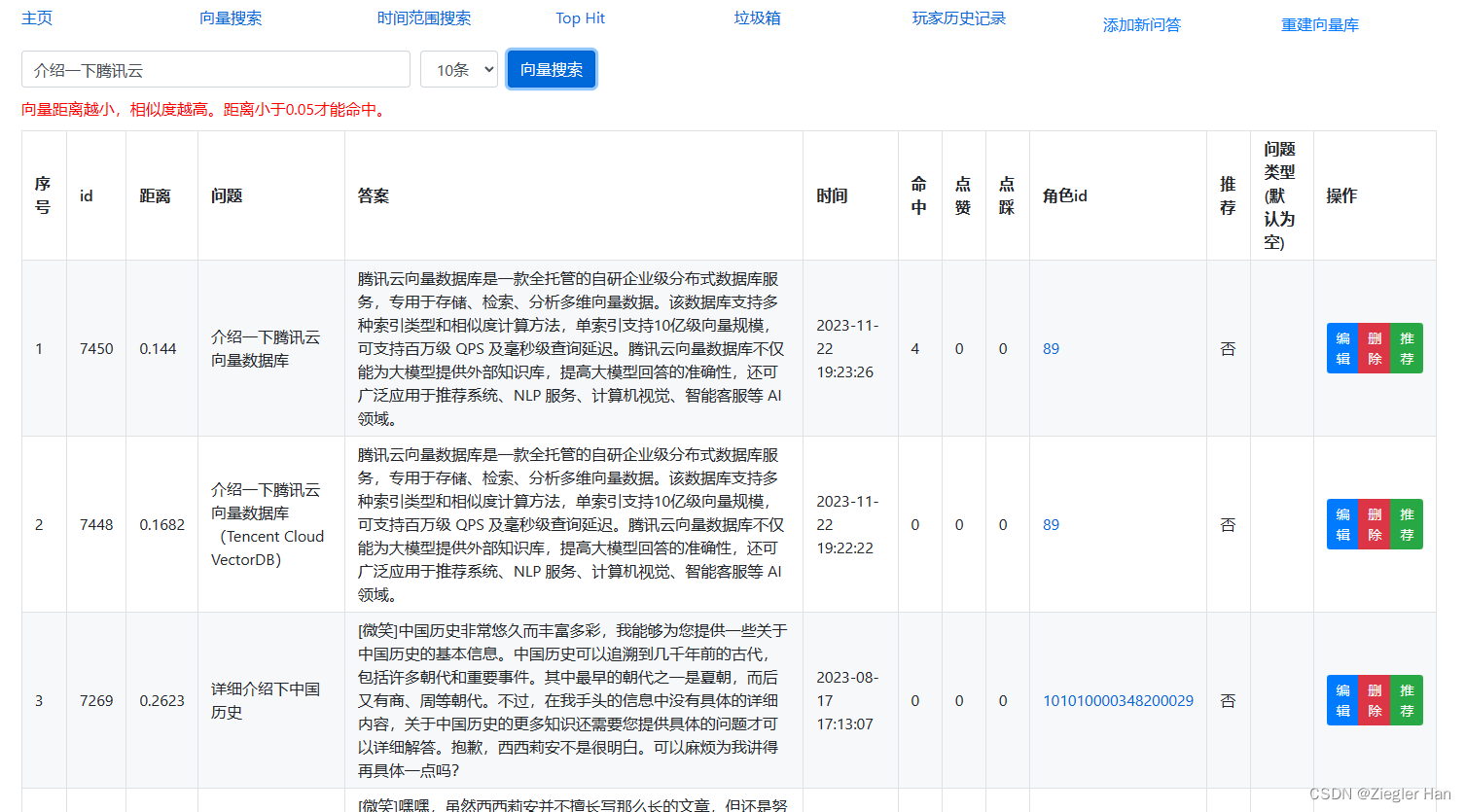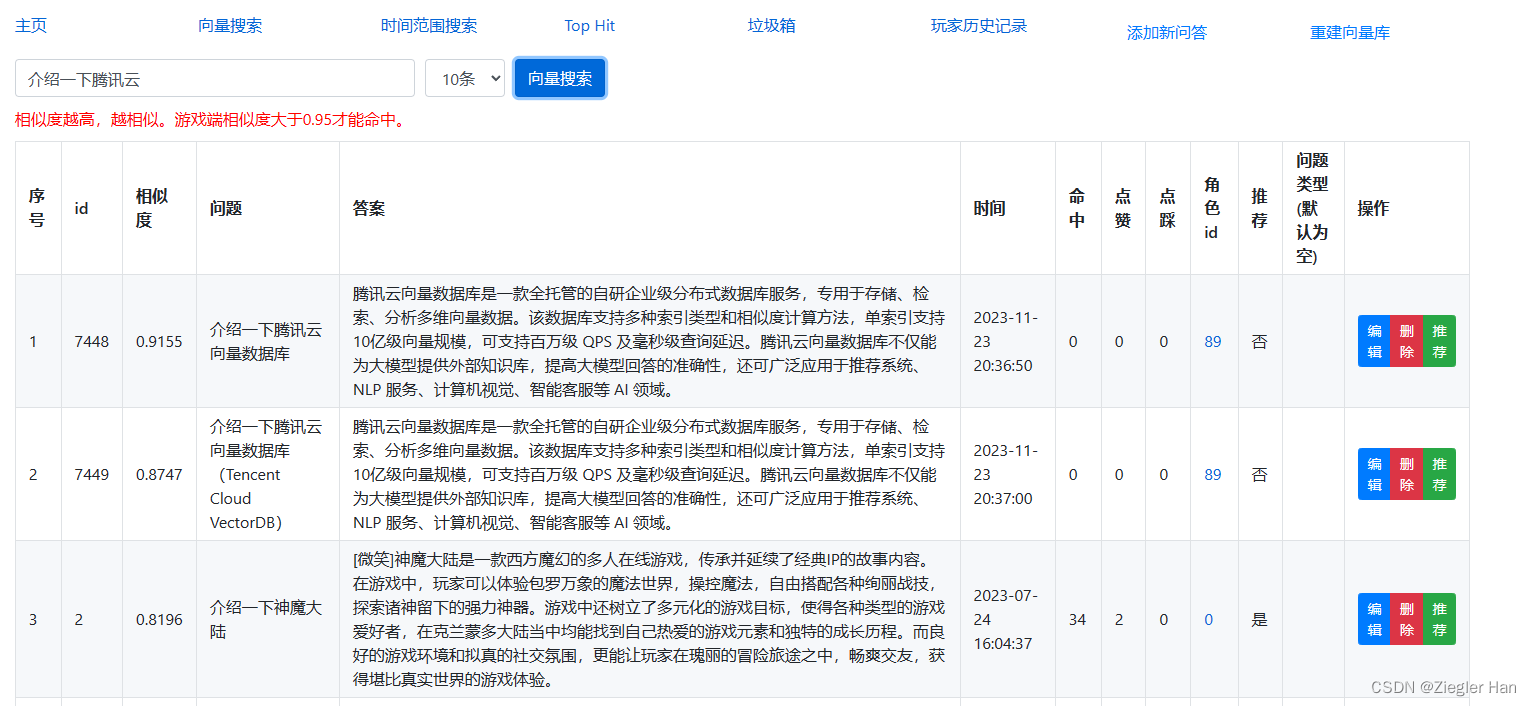為什么嘗試使用Tencent Cloud VectorDB替換Milvus向量庫?
亮點:Tencent Cloud VectorDB支持Embedding,免去自己搭建模型的負擔(搭建一個生產環境的模型實在耗費精力和體力)。
騰訊云向量數據庫是什么?
騰訊云向量數據庫是一款全托管的自研企業級分布式數據庫服務,專用于存儲、檢索、分析多維向量數據。該數據庫支持多種索引類型和相似度計算方法,單索引支持10億級向量規模,可支持百萬級 QPS 及毫秒級查詢延遲。騰訊云向量數據庫不僅能為大模型提供外部知識庫,提高大模型回答的準確性,還可廣泛應用于推薦系統、NLP 服務、計算機視覺、智能客服等 AI 領域。
Milvus是什么?
Milvus是在2019年創建的,其唯一目標是存儲、索引和管理由深度神經網絡和其他機器學習(ML)模型生成的大規模嵌入向量。作為一個專門設計用于處理輸入向量查詢的數據庫,它能夠處理萬億級別的向量索引。與現有的關系型數據庫主要處理遵循預定義模式的結構化數據不同,Milvus從底層設計用于處理從非結構化數據轉換而來的嵌入向量。
項目展示


項目介紹游戲內部接入ChatGPT的智能NPC,可以與她進行語音交流。可以回答與游戲相關的問題(這個專業問題是為了編寫這個文章,專門添加到問答緩存庫中的,游戲內會拒絕回答此類問題)。為了加快ChatGPT的回復速度和降低ChatGPT的費用,增加問答緩存機制。這里運用向量數據庫的相似文本相似度高的特性,通過向量搜索,匹配相似度大于一定值,例如:0.95。搜索到相似問題,直接返回答案,不在進行ChatGPT訪問。
其次,存在緩存,針對相似問題,還可以給予特定回復答案。例如上面示例,當提問“介紹一下騰訊向量數據庫”,直接回復“騰訊云向量數據庫是一款全托管的自研企業級分布式數據庫服務,專用于存儲、檢索、分析多維向量數據。該數據庫支持多種索引類型和相似度計算方法,單索引支持10億級向量規模,可支持百萬級 QPS 及毫秒級查詢延遲。騰訊云向量數據庫不僅能為大模型提供外部知識庫,提高大模型回答的準確性,還可廣泛應用于推薦系統、NLP 服務、計算機視覺、智能客服等 AI 領域。”
為什么使用向量數據庫?
重點:速度
向量相似度匹配是很長的數組,例如:bge-large-zh模型文本轉向量,生成的是768維的float數組。拿問題文本轉換為的768維向量與緩存的所有問題的向量進行相似性計算,然后獲取最相似的幾條數據,這個運算量非常大,速度非常慢。
測試代碼:
與300個768維向量進行相似比對,獲取最相似的一條數據,耗時幾秒鐘。按照這個速度,如果與幾千上萬條數據進行這么計算,簡直無法忍受。
這時就必須使用向量數據庫了,向量數據庫可以支持毫秒級檢索上百萬行數據。本人曾使用Milvus數據庫,分別插入1000行數數據和插入10萬行數據,然后進行搜索對比,都在幾十毫秒返回結果,數據量的增多,對檢索速度幾乎沒有任何影響。
本項目哪里需要使用向量數據庫?
- 玩家提問:玩家提問先通過embedding轉換為向量,在向量庫檢索相似的問題,滿足匹配條件,直接返回對應的答案。
- 后臺相似問題檢索:后臺通過向量檢索相似問題,以便對特定問題進行增刪改查。
使用騰訊云向量數庫(Tencent Cloud VectorDB)的優點?
- 支持Embedding:騰訊云向量數據庫(Tencent Cloud VectorDB)提供將非結構化數據轉換為向量數據的能力,目前已支持文本 Embedding 模型,能夠覆蓋多種主流語言的向量轉換,包括但不限于中文、英文。對于小型項目這是一個非常大的優勢。可以降低自己搭建embedding模型或者使用第三方embedding模型的成本。
- FilterIndex的field_type支持數據類型簡單:只有String和Uint64,使用起來非常省心。而Milvus數據支持10幾種類型,對于初學者不友好,還要研究具體如何使用。
指定 Filter 字段的數據類型。取值如下:
String:字符型。若 name 為 id,則該參數固定為 FieldType.String。
Uint64:指無符號整數,該參數可設置為 FieldType.Uint64。
研究Tencent Cloud VectorDB,測試并封裝代碼庫my_tc_vector_db.py
if __name__ == '__main__':# 初始化myTcVectorDB = MyTcVectorDB("http://****************.tencentclb.com:30000", "root","2epSOV3HK6tiyALo6UqE3mGV**************")# 刪除數據庫myTcVectorDB.drop_collection("db-qa", "question_768")myTcVectorDB.drop_database("db-qa")# 創建數據庫myTcVectorDB.create_database("db-qa")# 創建索引和embedding,并創建集合index = Index(FilterIndex(name='id', field_type=FieldType.String, index_type=IndexType.PRIMARY_KEY),FilterIndex(name='question', field_type=FieldType.String, index_type=IndexType.FILTER),VectorIndex(name='vector', dimension=768, index_type=IndexType.HNSW,metric_type=MetricType.COSINE, params=HNSWParams(m=16, efconstruction=200)))embedding = Embedding(vector_field='vector', field='text', model=EmbeddingModel.BGE_BASE_ZH)collection = myTcVectorDB.create_collection("db-qa", "question_768", index, embedding)# 批量插入myTcVectorDB.upsert("db-qa", "question_768", [Document(id='0001', text='羅貫中', question='羅貫中'),Document(id='0002', text='吳承恩', question='吳承恩'),Document(id='0003', text='曹雪芹', question='曹雪芹'),Document(id='0004', text='郭富城', question='郭富城')])# 單條插入myTcVectorDB.upsert_one("db-qa", "question_768", id='0005', text='周杰倫', question='周杰倫')myTcVectorDB.upsert_one("db-qa", "question_768", id='0006', text='林俊杰', question='林俊杰')# 刪除0003myTcVectorDB.delete_by_id("db-qa", "question_768", "0003")# 文本搜索(無需向量轉換)text = myTcVectorDB.search_by_text("db-qa", "question_768", "郭富城")# 打印結果print_object(text)# 僅打印idif len(text[0]) > 0:for i in text[0]:print(i['id'])
解釋代碼功能:
-
初始化:傳入tcVectorDB的url、username和key,創建myTcVectorDB.
-
刪除數據庫db-qa下的數據集question_768,然后刪除數據庫db-qa
-
重新創建數據庫db-qa
-
指定索引和embedding,并創建集合question_768:這里指定id為主鍵、question為FilterIndex標量索引,vector為VectorIndex向量索引(注意官方文檔說明:指定向量索引字段名,固定為 vector。)因為使用中文檢索,Embedding使用BGE_BASE_ZH。

-
批量插入測試數據
-
單行插入測試數據
-
測試刪除單行數據
-
測試文本搜索,并打印結果
MyTcVectorDB庫代碼
import jsonimport tcvectordb
from tcvectordb.model.collection import Embedding
from tcvectordb.model.document import Document, SearchParams
from tcvectordb.model.enum import ReadConsistency, MetricType, FieldType, IndexType, EmbeddingModel
from tcvectordb.model.index import Index, FilterIndex, VectorIndex, HNSWParamsclass MyTcVectorDB:def __init__(self, url: str, username: str, key: str, timeout: int = 30):self._client = tcvectordb.VectorDBClient(url=url, username=username, key=key,read_consistency=ReadConsistency.EVENTUAL_CONSISTENCY, timeout=timeout)def create_database(self, database_name: str):"""Create a database:param database_name: database name:return: database"""return self._client.create_database(database_name=database_name)def drop_database(self, database_name: str):"""Drop a database:param database_name: database name:return: result"""return self._client.drop_database(database_name=database_name)def create_collection(self, db_name: str, collection_name: str, index: Index, ebd: Embedding):db = self._client.database(db_name)# 第二步,創建 Collectioncoll = db.create_collection(name=collection_name,shard=1,replicas=0,description='this is a collection of question embedding',index=index,embedding=ebd)return colldef drop_collection(self, db_name: str, collection_name: str):"""Drop a collection:param db_name: db name:param collection_name: collection name:return: result"""db = self._client.database(db_name)return db.drop_collection(collection_name)def upsert_one(self, db_name: str, collection_name: str, **kwargs):"""Upsert one document to collection:param db_name : db name:param collection_name: collection name:param document: Document:return: result"""db = self._client.database(db_name)coll = db.collection(collection_name)res = coll.upsert(documents=[Document(**kwargs)])return resdef upsert(self, db_name: str, collection_name: str, documents):"""Upsert documents to collection:param db_name : db name:param collection_name: collection name:param documents: list of Document:return: result"""db = self._client.database(db_name)coll = db.collection(collection_name)res = coll.upsert(documents=documents)return resdef search_by_text(self, db_name: str, collection_name: str, text: str, limit: int = 10):"""Search documents by text:param db_name : db name:param collection_name: collection name:param text: text:return: result"""db = self._client.database(db_name)coll = db.collection(collection_name)# searchByText 返回類型為 Dict,接口查詢過程中 embedding 可能會出現截斷,如發生截斷將會返回響應 warn 信息,如需確認是否截斷可以# 使用 "warning" 作為 key 從 Dict 結果中獲取警告信息,查詢結果可以通過 "documents" 作為 key 從 Dict 結果中獲取res = coll.searchByText(embeddingItems=[text],params=SearchParams(ef=200),limit=limit)return res.get('documents')def delete_by_id(self, db_name: str, collection_name: str, document_id):"""Delete document by id:param db_name : db name:param collection_name: collection name:param document_id: document id:return: result"""db = self._client.database(db_name)coll = db.collection(collection_name)res = coll.delete(document_ids=[document_id])return resdef print_object(obj):"""Print object"""for elem in obj:# ensure_ascii=False 保證中文不亂碼if hasattr(elem, '__dict__'):print(json.dumps(vars(elem), indent=4, ensure_ascii=False))else:print(json.dumps(elem, indent=4, ensure_ascii=False))
開始動手使用Tencent Cloud VectorDB在項目中替換Milvus
1、創建問題庫db-qa和集合question_768
與測試代碼基本一致
# 初始化myTcVectorDB = MyTcVectorDB("http://****tencentclb.com:30000", "root","2epSOV3HK6tiyALo6UqE3mGVMbpP*******")# 創建數據庫myTcVectorDB.create_database("db-qa")# 創建索引和embedding,并創建集合index = Index(FilterIndex(name='id', field_type=FieldType.String, index_type=IndexType.PRIMARY_KEY),FilterIndex(name='question', field_type=FieldType.String, index_type=IndexType.FILTER),VectorIndex(name='vector', dimension=768, index_type=IndexType.HNSW,metric_type=MetricType.COSINE, params=HNSWParams(m=16, efconstruction=200)))embedding = Embedding(vector_field='vector', field='text', model=EmbeddingModel.BGE_BASE_ZH)collection = myTcVectorDB.create_collection("db-qa", "question_768", index, embedding)
2、游戲端和后臺文本向量搜索,用MyTcVectorDB替換Milvus
兩處代碼基本一致。這里去掉文本轉向量的步驟,因為TcVectorDB支持Embedding
# 獲取問題轉換后的向量# success, vector = get_vector_from_text(question)# if not success:# return {"code": -1, "id": 0, "answer": "向量計算失敗"}# results = questionCollection.search(vector, limit)results = myVectorDB.search_by_text("db-qa", "question_768", question, limit)...
上面代碼需要注意一點,騰訊向量數據的search結果與milvus的搜索結果是不一樣的,需要做一下適配。
3、重建向量數據庫
問答緩存的數據保存在mysql數據庫,向量數據庫主要作用是向量搜索。如果更換向量庫,只需要重建向量庫即可。下面代碼:
- 從mysql中獲取所有的問題
- 遍歷所有問答
- 把問題作為向量索引,問答的id為標量索引插入向量庫中
當前mysql數據庫中有大幾千條數據,重新構建向量就耗時10分鐘左右。
def rebuild_vector():# 查找所有的數據select_all = qaTable.select_all_qa()# 遍歷所有的數據for qa in select_all:insertId = qa[0]question = qa[1]timestamp = int(time.time())print(question)# 計算向量# 更新向量# success, vector = get_vector_from_text(question)# if not success:# # 向量計算失敗,question# logging.error("向量計算失敗,insertId:%s, question:%s", insertId, question)# continue# # 刪除原有的向量# questionCollection.delete_question(insertId)# # 插入新的向量# questionCollection.insert_question(insertId, vector, question, timestamp)myVectorDB.delete_by_id("db-qa", "question_768", str(insertId))myVectorDB.upsert_one("db-qa", "question_768", id=str(insertId), text=question, question=question)return "重建向量庫成功"
4、修改后臺展示,看下修改后的效果圖
- 使用的文本轉向量的模型是:BGE_BASE_ZH
- 向量索引是:VectorIndex(name=‘vector’, dimension=768, index_type=IndexType.HNSW, metric_type=MetricType.COSINE, params=HNSWParams(m=16, efconstruction=200))
- 搜索文本返回結果代表的是相似度,保存在score中。
總結:
- 使用騰訊向量數據庫要比使用Milvus更加簡單易用,無需自己部署服務器。
- 騰訊云向量庫支持主流Embedding,直接支持文本向量搜索,避免自己部署Embedding模型,并避免調用文本轉向量的過程。對于開發者來說非常便利。
如果是個人,或者小型項目開發,非常值得使用騰訊云數據庫。如果是大型項目,不缺錢的話也非常推薦使用騰訊云數據庫,穩定、高效且安全。

和表空間(Tablespace))













)



